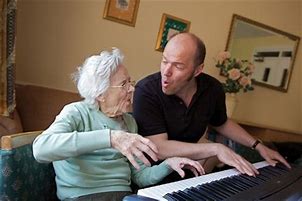The Sound of Serenity
- Jul 6, 2023
- 4 min read
Updated: Jul 18, 2023
"...medicine, law, business, engineering, these are noble pursuits and necessary to sustain life. But poetry, beauty, romance, love, (music): these are what we stay alive for."
Robin Williams, as John Keating
Dead Poets Society
When was the last time a song evoked feelings of nostalgia for you? Sadness, happy memories, thoughts of a special person or place? "Our long-term memory can be divided into two distinct types, namely implicit memory and explicit memory. Implicit memory is a form of classical conditioning. An event, an emotion, and a song get connected through implicit memory. When a piece of music is paired with a very emotional event, it can be an effective cue to bring back the strong emotion that was felt at that moment. For example, the song “Candle in the Wind” is often associated with Princess Diana because Elton John performed it at her funeral." (1)
Music has been shown to stimulate the Alzheimer's brain. It has also been linked to improved quality of life, feelings of peace, spirituality and hope, and reduced pain. For those living in long-term care communities, music, specifically music that is offered in-person, is not only therapeutic, but it can also arguably be a necessary part of end-of-life care, dementia care and improved quality of life for residents.

Therapeutic Musicians of Coastal Carolina is one of several CMP-funded projects that have incorporated the Arts into long-term care communities, providing therapeutic benefits to residents through engagement, socialization, a decrease in anxiety and depression, and a reduction in the use of pharmacological approaches to treatment of mental health and cognitive behaviors. According to an article written by the National Library of Medicine, music is "an inexpensive, easily implemented, and highly enjoyable means of treatment." (2)
It's amazing how something as 'simple' as providing someone, or a group of individuals, with music can have so many therapeutic benefits. Certified Clinical Musician, David Key, with the Therapeutic Musicians Project, states that "The instrument I play is a simple system (just 6 tone holes, with no keys) Irish flute I had made for me specifically for this work. It is lower pitched than the traditional Irish flute and is made with a beautiful African blackwood (in the rosewood family). I bring to the playing of this unique instrument my technique and abilities as a musician, but it is the sustained sounds of this flute that transport the listener. My playing provides moments of beauty for those residents. That is why there are closed eyes and smiles, tears, and energetic requests for me to "come back anytime!"
"What I provide playing bedside for those who are often long-term residents is significant. I am providing them with something to 'stay alive for."

"Larry is a resident that is in his 60's but his brain never developed past the age of 5. I have played for Larry for about a year and a half and he learned to recognize me as the harpist who played Santa Claus is coming to Town, his favorite song. Every time I would enter the room to greet Larry, he would break out singing Christmas songs even though it was no longer Christmas," laments Shari Hancock, a Harpist, and Certified Music Practitioner with the Therapeutic Musicians Project. "His loud singing could be heard down the hall and the other residents would mostly smile. Within the past month Larry's organs have started to decline and Hospice has been called in. He is now primarily in a nonresponsive state until he hears the harp. For the past few weeks, when I would visit Larry and begin playing my harp, I noticed him trying to arouse and get the words out to Santa Claus is Coming to Town with a little smile. While it is so hard to watch him decline, it also warms my heart to know that our time together playing and singing Christmas songs were moments of happiness in Larry's last days."
Therapeutic projects such as this provide meaningful connections and create joyful memories in in the lives of residents, their loved ones, and the staff that provide care. Julie Rehder, Certified Music Practitioner and Therapeutic Musicians Project Director recalls "Sometimes, music brings everyone together. I was playing for an 88-year-old and her daughter and learned they liked gospel music. I started playing Will the Circle Be Unbroken and it seemed like a choir suddenly arrived because residents came out of their rooms and staff joined us in the dining area. The multi-harmonies and loud choruses stayed with me for the rest of the day. On another occasion I played the songs associated with various branches of the military. To see the men, snap to attention and salute as their song was played made me proud to be an American and honored to be in the presence of these heroes of World War II, Korea, and Vietnam."
One of the main purposes of the Civil Money Penalties Reinvestment Program is to support activities that benefit nursing home residents, including projects that involve the utilization of nonpharmacological approaches and the reduction of antipsychotic medications. Projects involving art, music, and pet therapy for long-term care communities are encouraged because of their proven benefits and ease of implementation. These projects can be offered to a wide range of residents in individual or group settings and boast a number of genres and mediums to please individuals of any age, background, or culture.
Thank you to Julie Rehder, Certified Music Practitioner and Project Director for the Therapeutic Musicians of Coastal Carolina Project, and to Certified Music Practitioners, for their submission of these personal reflections. You can listen to these talented individuals on YouTube.
(2) Music Intervention Approaches for Alzheimer’s Disease: A Review of the Literature - PMC (nih.gov)
Excerpts from Personal Reflections were used in this article. The entire document, which includes testimonies from each TMCC musician, can be read in the attached document.







Comments